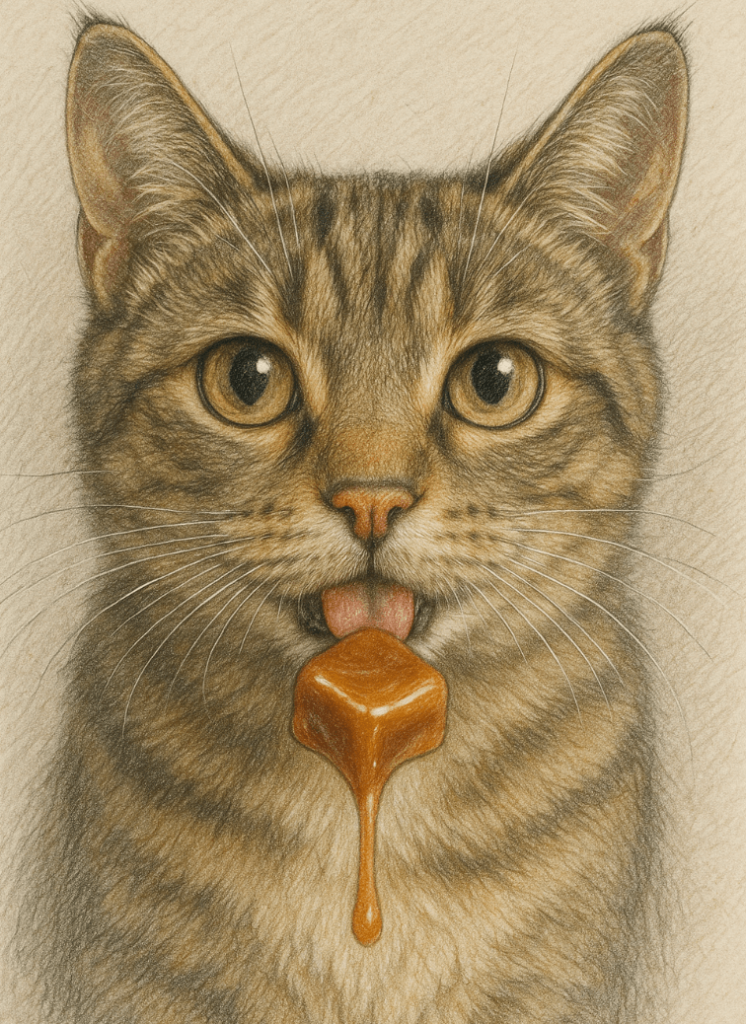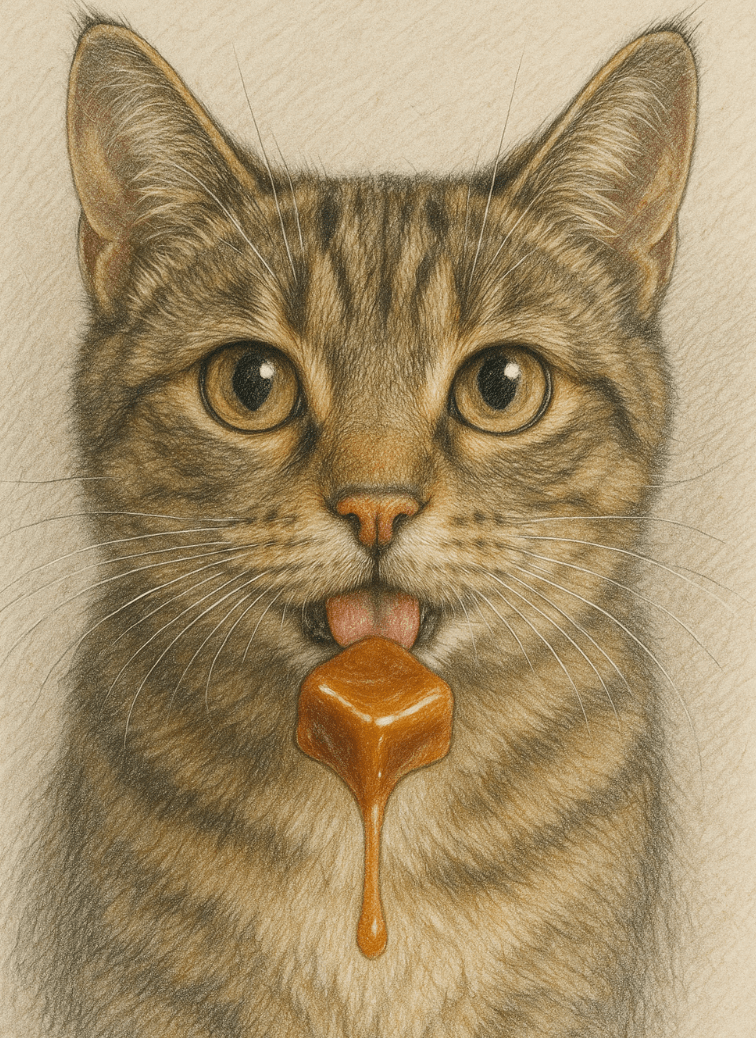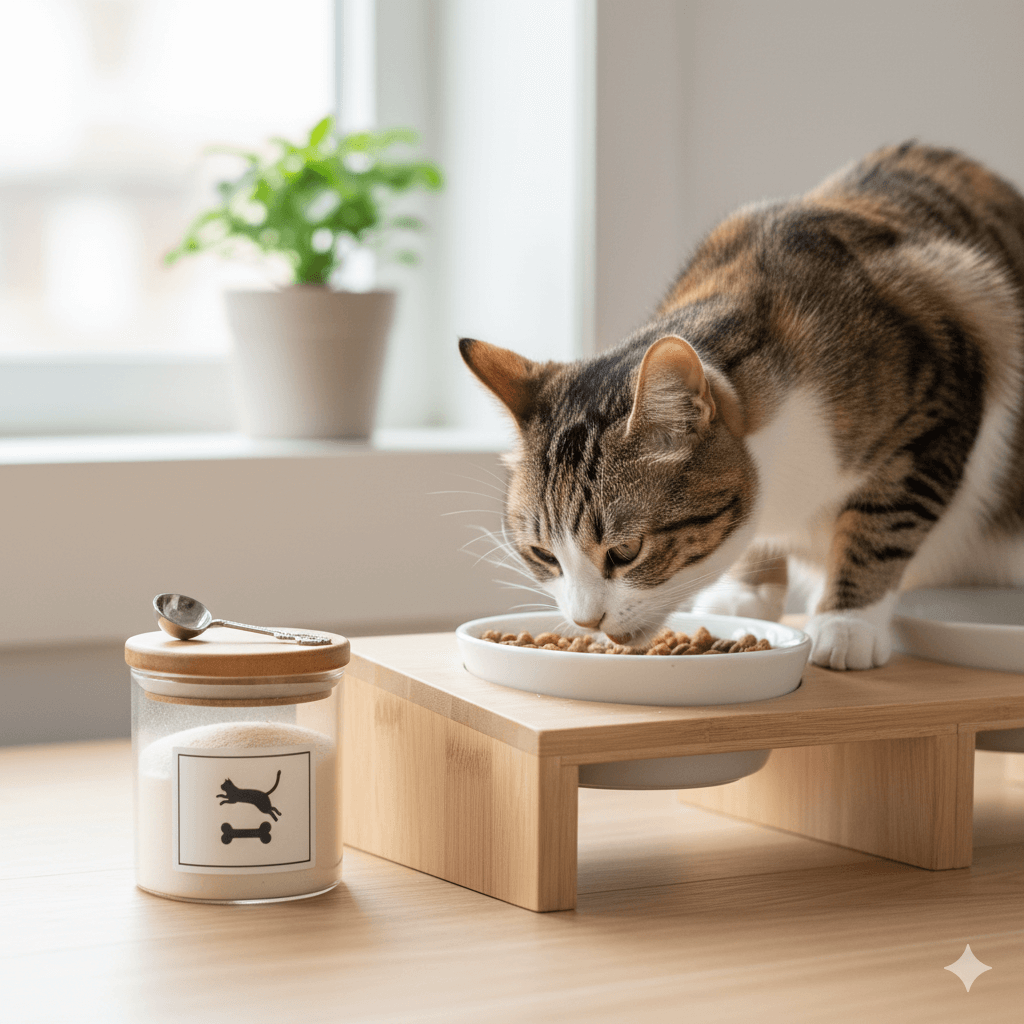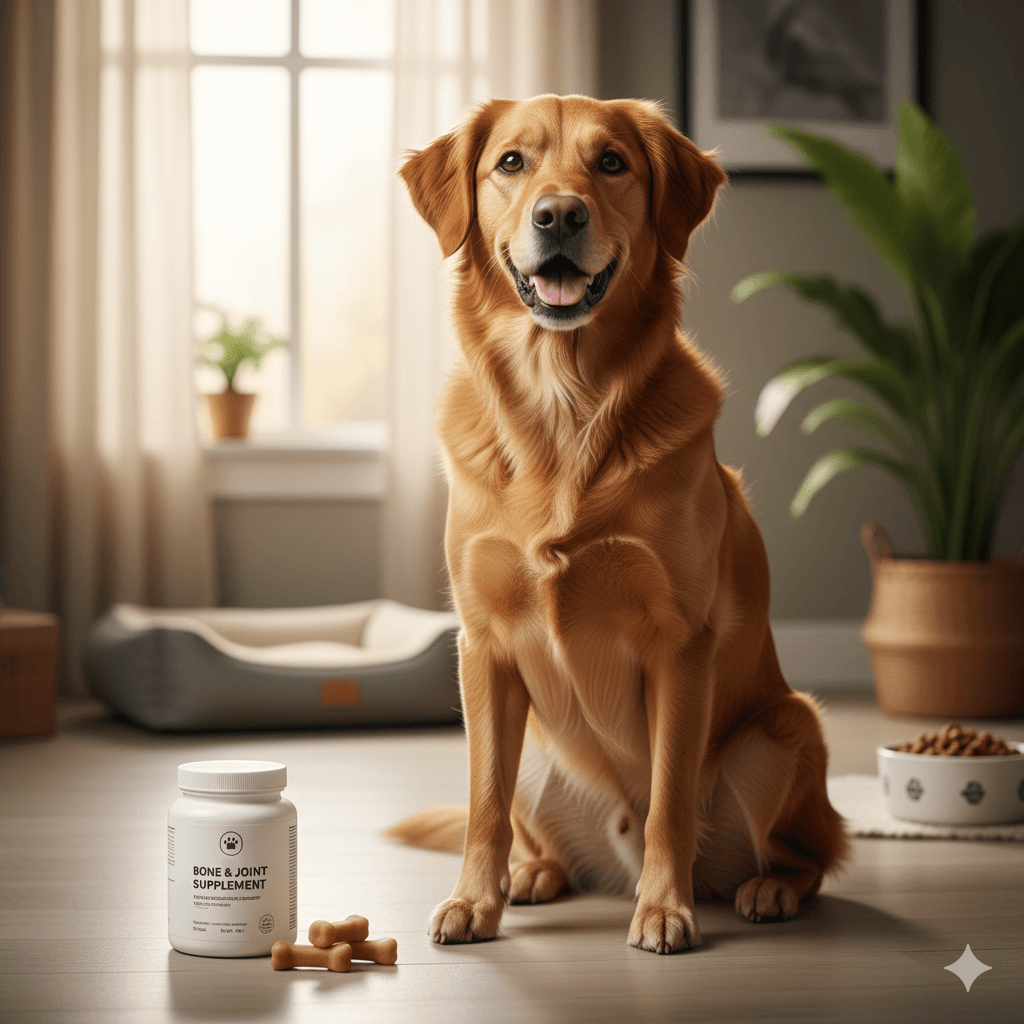Can Cats Eat Caramel?
Cats are naturally curious creatures, often sniffing around our snacks and meals to see if they can snag a bite. If you’ve ever wondered whether your feline friend can safely indulge in a sweet treat like caramel, you’re not alone. While caramel might seem harmless to us, it’s important to understand how certain human foods can affect cats. Cats have unique dietary needs and sensitivities, and what’s safe for humans isn’t always safe for them. In this blog post, we’ll explore whether caramel is safe for cats, the potential risks involved, and healthier alternatives to satisfy your cat’s curiosity about human food.
Why Caramel Is Not Safe for Cats
While caramel is a popular treat for humans, it poses several risks to cats due to its ingredients and texture. Feeding caramel to your cat can lead to health issues that range from mild discomfort to serious complications.
High Sugar Content:
Caramel is packed with sugar, which can upset your cat’s stomach and contribute to obesity or diabetes over time.Artificial Additives:
Many caramel products contain artificial flavors, colors, or preservatives that can irritate your cat’s digestive system.Choking Hazard:
The sticky texture of caramel can pose a choking risk, especially if your cat tries to swallow it whole or in large chunks.Lactose Intolerance:
Some caramel recipes include dairy, which many cats cannot digest properly, leading to diarrhea or vomiting.Toxic Ingredients in Variations:
Flavored caramels, such as chocolate-covered ones, may contain toxic ingredients like theobromine or xylitol, which are dangerous for cats.
These risks highlight why caramel should be avoided entirely when it comes to feeding your cat.
Signs Your Cat May Have Eaten Caramel
If your cat accidentally consumes caramel, it’s important to recognize the signs of distress or illness. Monitoring their behavior and physical condition can help you determine if veterinary care is needed.
Vomiting or Diarrhea:
These are common symptoms of digestive upset caused by high sugar levels or lactose intolerance.Excessive Drooling:
Sticky foods like caramel can cause drooling as your cat struggles to clean their mouth.Lethargy or Weakness:
A sudden lack of energy may indicate that your cat is feeling unwell after consuming caramel.Difficulty Breathing:
Choking on caramel or an allergic reaction could lead to labored breathing, requiring immediate attention.Increased Thirst or Urination:
High sugar intake may cause temporary spikes in blood sugar levels, prompting excessive thirst.
Spotting these signs early allows you to act quickly and ensure your cat receives proper care.
Check this guide 👉Can Cats Eat Lamb? Best 7 Expert Tips!
Check this guide 👉Can Cats Eat Prosciutto? Best 7 Expert Tips!
Check this guide 👉Can Cats Eat Cookies? Best 7 Expert Tips!

Safe Treats for Cats | Unsafe Human Foods for Cats |
|---|---|
Plain cooked chicken (no seasoning) | Chocolate or cocoa-based products |
Small pieces of banana | Caramel or sugary candies |
Steamed green beans | Onions, garlic, or chives |
Watermelon (seedless) | Grapes or raisins |
Catnip-infused treats | Alcohol or caffeinated beverages |
Healthier Alternatives to Caramel for Cats
If you want to spoil your cat with a special treat, there are plenty of healthier options that won’t harm their delicate systems. Here are some safer choices to consider.
Plain Cooked Meat:
Small portions of plain chicken, turkey, or beef provide protein without added sugars or spices.Cat-Specific Treats:
Commercially available cat treats are formulated to meet their nutritional needs and come in enticing flavors.Fruit Snacks:
Apples (without seeds), blueberries, or watermelon make refreshing and safe occasional treats.Homemade Cat Treats:
Simple recipes using ingredients like tuna or pumpkin allow you to control exactly what goes into your cat’s snack.Freeze-Dried Proteins:
Freeze-dried chicken or salmon offers a crunchy, nutrient-rich option that most cats adore.
Offering these alternatives ensures your cat enjoys tasty treats without compromising their health.
Tips for Preventing Your Cat from Eating Harmful Foods
Prevention is key to keeping your cat safe from potentially harmful human foods like caramel. Follow these tips to create a safer environment for your furry friend.
Store Food Safely:
Keep sweets, candies, and other tempting treats out of reach to prevent accidental ingestion.Supervise Shared Spaces:
Watch your cat closely during meal times or when snacks are within their access.Educate Family Members:
Ensure everyone in your household understands which foods are off-limits for cats.Provide Distractions:
Offer toys or interactive playtime to redirect your cat’s attention away from human food.Know Emergency Contacts:
Save your veterinarian’s number and local animal poison control hotline in case of accidental exposure.
Taking these precautions minimizes the risk of your cat encountering harmful foods.
Common Mistakes Pet Owners Make When Feeding Cats
Feeding cats human food can lead to unintended consequences if done carelessly. Avoid these common mistakes to keep your pet safe and healthy.
Assuming Human Food Is Safe:
Just because something is edible for humans doesn’t mean it’s safe for cats. Always research before sharing.Ignoring Portion Sizes:
Even safe foods can cause problems if given in excessive quantities; moderation is key.Overlooking Allergies:
Some cats may have sensitivities to certain ingredients, even in otherwise “safe” foods.Not Reading Labels Carefully:
Processed human foods often contain hidden additives that can harm cats.Rewarding Begging Behavior:
Giving in to begging encourages unhealthy habits and increases the chance of feeding inappropriate items.
Avoiding these pitfalls ensures your cat maintains a balanced and nutritious diet.
Understanding Your Cat’s Dietary Needs
Cats require specific nutrients to thrive, and their diets should reflect those needs. Understanding their biology helps explain why certain foods, like caramel, are unsuitable.
Obligate Carnivores:
Cats rely primarily on animal-based proteins and fats for energy, unlike omnivorous humans.Limited Ability to Process Carbs:
Their bodies aren’t designed to handle high-carbohydrate or sugary foods efficiently.Essential Nutrients Like Taurine:
Cats need taurine, an amino acid found in meat, to support heart and eye health.Hydration Through Food:
Wet food mimics their natural prey-based diet, helping them stay hydrated.No Sweet Tooth Evolution:
Cats lack the taste receptors for sweetness, meaning they don’t naturally crave sugary treats.
Knowing these facts underscores why sticking to cat-specific foods is crucial for their long-term health.
Fun Ways to Treat Your Cat Without Harmful Foods
Spoiling your cat doesn’t have to involve risky human snacks. These fun and creative ideas will delight your feline friend while keeping them safe.
Interactive Toys:
Puzzle feeders or treat-dispensing toys engage their minds and reward them with healthy snacks.DIY Catnip Toys:
Stuff socks or fabric scraps with dried catnip for a simple yet irresistible toy.Grooming Sessions:
Brushing your cat can feel like a luxurious spa day, strengthening your bond and keeping their coat shiny.Outdoor Adventures (Safely):
Leash training allows your cat to explore the outdoors safely under your supervision.Affection and Playtime:
Sometimes, the best treat is quality time spent cuddling or playing with your favorite feline.
These activities show love and care without relying on potentially harmful human foods.
Frequently Asked Questions About Cats and Caramel
What happens if my cat eats caramel?
Mild cases may cause upset stomach, but larger amounts could lead to more severe issues like choking or toxicity.
Can kittens eat caramel?
No, kittens are even more vulnerable to the effects of sugar and additives than adult cats.
Are all types of caramel unsafe for cats?
Yes, regardless of flavor or recipe, caramel contains ingredients that aren’t suitable for cats.
How much caramel is too much for a cat?
Even small amounts can upset your cat’s stomach, so it’s best to avoid giving them any at all.
What should I do if my cat eats caramel?
Monitor for symptoms and contact your vet immediately if you notice anything unusual.
Prioritizing Your Cat’s Health Over Sweet Temptations
While caramel might look appealing to us, it’s simply not worth the risk when it comes to feeding it to your cat. Their unique physiology and dietary requirements mean they thrive best on species-appropriate foods. By understanding the dangers of caramel and opting for healthier alternatives, you can ensure your cat stays happy, healthy, and full of energy. Remember, your cat relies on you to make the best choices for their well-being—so stick to treats that truly nourish their bodies and bring joy to their lives.
Understanding Bone Supplement for Cats: Best 7 Expert Tips! – Safe, vet-approved guidance for strong feline bones & balanced nutrition.
Bone Supplement for Dogs: Best 7 Expert Tips! – Expert guide to calcium, collagen & bone health for every life stage.
Understanding Can Cats Get Sunburn: Best 7 Expert Tips! – Protect your feline from UV damage with vet-backed prevention strategies.
How to Train a Seizure Alert Dog: Best 7 Expert Tips! – Learn expert-backed steps to nurture natural instincts into reliable, life-saving seizure alerts.





